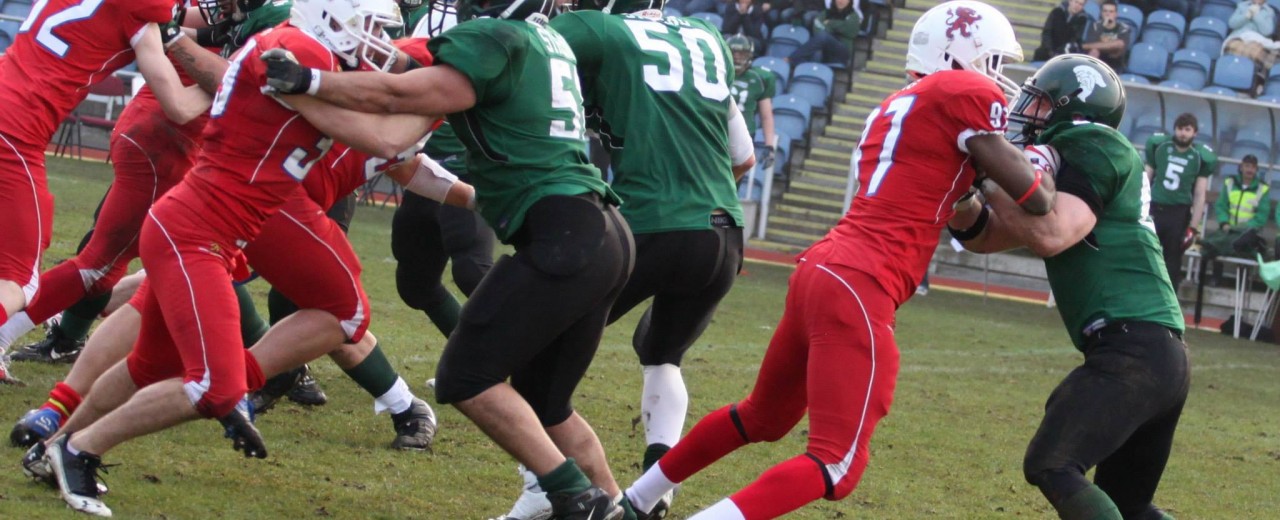2015/16 BUAFL Preview - New League Structure Throws Up Grudge Games Galore

All photos by Bec Edwards
With the big kick off only days away, we look ahead to some of the big match-ups in the university league...
The clocks have gone back and the leaves are falling off the trees, which for Britball means one thing – the university season is nearly here. With several teams kicking off this Saturday October 31st, students all over the UK are getting ready to kit up.
BUCS has re-arranged the leagues again this season, with the BUAFL this year split into three tiers, after the arrangement of last season’s new two-tier system lumped many strong sides in with developing programs.
Barring the promoted and relegated teams, the Premier League remains unchanged – in the Northern conference, Sheffield Sabres have been replaced by their neighbours Sheffield Hallam Warriors.
Hallam start life in the Premier League at home to Loughborough hoping to succeed where their local rivals failed and stamp their authority on the top division. Elsewhere, Derby Braves will go into the season as underdogs having lost 7 of their 8 games in 2014/15, and they arguably have the toughest start in the country with a long opening day trip to face the back-to-back national champion Stirling Clansmen this Saturday October 31st. The Clan have a new Head Coach in the form of Victor Peredo, their former defensive co-ordinator, but they’re still the team to beat. They will be expecting to continue to be the benchmark for university football.
Meanwhile in the Southern conference, Kingston Cougars have moved up to take the place of Brighton Tsunami, and start at home against last season’s losing finalists Hertfordshire Hurricanes. Herts’ 7 regular season victories in 2014/15 included 3 shutouts, 281 points scored and an average win margin of 35.4, and the high scoring five-time champions will be shooting for the ultimate glory once again, along with the ever-powerful Birmingham Lions, who also went 7-1 last year and reached the play-offs. Only a handful of Birmingham’s 2013 championship-winning squad remain, but they are hungry for revenge after consecutive post-season defeats to the dominant Clansmen.
Bath Killer Bees will be aiming to sharpen up their offence – leaving out their two big wins against relegated Brighton, they averaged just 9.3 points per game last season, while Imperial Immortals, of West London, are focused on maintaining their Premier League status, but won’t lie down and be underdogs – they’ve been working on their intensity and execution, and are confident they deserve their place in the top tier. The Southern conference should be a hot contest.
2014 finalists Birmingham Lions and 2015 finalists Hertfordshire Hurricanes both have a score to settle with the Stirling Clansmen.
The new Tier One and Tier Two are where the new league structure gets interesting – the lower levels are now arranged into smaller regional divisions to reflect the Premier League’s regular season format of five teams playing each other home and away. It is hoped that this will make for a more balanced and competitive season, and it has thrown up some interesting matchups, as most of the teams in Tier 1 are coming off of winning seasons in the previous setup.
Glasgow Tigers, beaten by Hallam in last season’s Tier 1 final, find themselves the only Scottish team in the new 1A Scottish/North. The Tigers were 8-0 in 2014/15, and with their nearest opponents now over two and a half hours away, the University of Glasgow could become a horribly difficult place to visit. They begin at home this Saturday against Lancaster Bombers, while Sunderland Spartans travel to Northumbria Mustangs.
Of the other play-off teams from last year, Northern conference semi-finalists Aberystwyth Tarannau and Southern conference semi-finalists Swansea Titans find themselves together in the 1A Western, while Surrey land in 1A South, Cambridge join Brighton in 1A South Eastern, and Nottingham Trent get to continue their city rivalry with Nottingham in 1A Midlands. All these teams will hope they can continue their momentum and reach the playoffs again, but with every division so competitive, they will all have to work extremely hard for every win.

This season's new structure adds a third tier. The blue teams are new to the league.
The league’s younger or developing teams will be grateful for the addition of a third tier, which will allow them to grow by playing competitive football rather than face a gauntlet of inevitable heavy defeats. Keele Crusaders, for example, have had to endure being whipping boys for their first few seasons, only managing 12 points last year and losing by more than 40 on 6 occasions. (They did finally earn a hard fought victory against Manchester Metropolitan in the last game.) It takes incredible commitment for these teams to keep putting themselves out there, and their efforts should be better rewarded in the new structure.
Keele are joined in 2A North West by Bangor Muddogs and Liverpool John Moores Fury, along with new teams from Edge Hill and University of Liverpool, turning Merseyside into an interesting three-way rivalry. With LJMU and UoL overlapping each other in the city centre and Edge Hill only a few miles away, it promises to be fiery. The ambition of the senior league’s Merseyside Nighthawks, who haven’t lost a game in over two years, has bled into all three of these teams via players and coaches, and none of them hope or expect to stay in the second tier for long.
Merseyside isn’t the only place this is happening - Tier Two is filled with fierce city rivalries. Edinburgh and Edinburgh Napier share their city and now the 2A Scottish/Northern division with newbies Heriot Watt, Manchester and Manchester Met stay together in 2A North/Midlands, the universities of 2A Midlands have always been connected due to their links with senior sides, Oxford and Oxford Brookes will meet in 2A South East, and this season’s fourth and final new team East London Titans join 2A London to add yet another dog into the fight for the capital.
All in all, the new league structure is about stimulating the hot-blooded, hard-fought competition that American football is known and loved for. The smaller regional divisions and consistent home and away fixtures mean that players are going to get to know each other well, and with play-offs and varsity games throwing up the possibility of teams squaring off up to four times per season, we’re going to see some real grudge matches develop over the next couple of years.
Let’s get stuck in…



